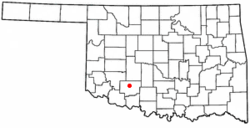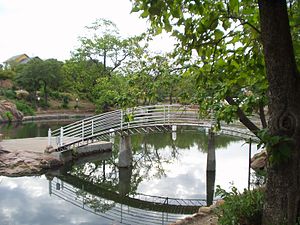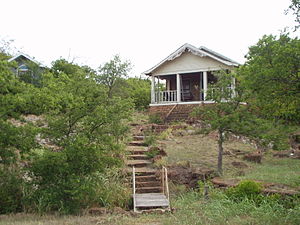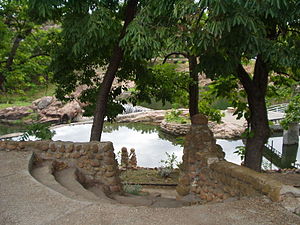- Medicine Park, Oklahoma
-
Medicine Park, Oklahoma — Town — Location of Medicine Park, Oklahoma Coordinates: 34°44′04″N 98°28′39″W / 34.7344071°N 98.4776209°W Country United States State Oklahoma County Comanche Area - Total 2.1 sq mi (5.348265 km2) - Land 2 sq mi (5.219551 km2) - Water 0 sq mi (0.128714 km2) Elevation 1,270 ft (387 m) Population (2010) - Total 382 - Density 185/sq mi (71.4/km2) Time zone Central (CST) (UTC-6) - Summer (DST) CDT (UTC-5) ZIP code 73557 Area code(s) 580 FIPS code 40-47350[1] GNIS feature ID 1095292[2] 
Medicine Park is a town in Comanche County, Oklahoma, United States, situated in the Wichita Mountains near the entrance to the 60,000-acre (240 km2) Wichita Mountain Wildlife Refuge. Medicine Park has a long history as a vintage cobblestone resort town. Medicine Park is also located near the city of Lawton and Fort Sill. It is an exurb, part of the Lawton Metropolitan Statistical Area. Many of the original structures are constructed out of naturally formed cobblestones—these red granite cobblestones are unique to the Wichita Mountains. The population was 382 at the 2010 census.
Contents
History
The community has a rich and colorful history. Originally founded on the 4th of July 1908 by Elmer Thomas, a young lawyer who had just become the first Senator of Oklahoma, Medicine Park was Oklahoma’s first planned tourism resort.
In the spring of 1906, just five years after the establishment of the Wichita Mountains National Forest, Elmer Thomas envisioned the need not only for a recreational area but also the need for a permanent water source for the budding and newly founded City of Lawton. Over a period of a few years, he and a partner, Hal Lloyd from Altus, quietly purchased approximately 900 acres (3.6 km2) of what is now the cobblestone community of Medicine Park.
When the resort first opened, it consisted merely of a large surplus Army tent with a wooden floor where hot meals were served. Two dams were constructed on Medicine Creek to form Bath Lake Swimming Hole and a limited number of campsites were built. Over a period of approximately 4 years, numerous improvements were added, and the area began to take on the look and feel of a bona fide resort.
About this same time period, numerous such resorts were opening near the entries of other newly founded National Parks and National Forests all across the country. The American public held a remarkable fascination with nature. The coming of the automobile gave unprecedented access to our country’s natural wonders. Resorts began springing up nationwide to provide these new found "tourists" with food, lodging and entertainment.
Tourists flocked to the area from around the state and North Texas to enjoy the mountains, wildlife, swimming, good food and lodging. Soon, there were two inns—the Outside Inn and the Apache Inn (which was formerly the Press Association Clubhouse) -- Baird’s Health Sanitarium (which featured clay tennis courts and a spa) -- a Dance Hall, The Medicine Park Lodge (atop Mount Dunbar), a Canteen, Petting Zoo, Bath House, General Store, School, Bait Shop, Hydro Electric Power Plant and the infamous Dam Café. Bob Wills and The Texas Playboys (the kings of western swing) became regulars at the Dance Hall from 1929 through the late 1930s. Numerous other famous bands of the day made their way through Medicine Park in route to big city venues in Oklahoma City, Dallas and Fort Worth.
The entire Bath Lake Park was landscaped with beautiful gardens, large trees, foot bridges and grassy areas for visitors to lounge around, sunbathe and enjoy the natural beauty. The area flourished during the late teens to the 1940s as the “Jewel of the Southwest.”
The nearby Wichita Mountains Wildlife Refuge and Lake Lawtonka attracted thousands of people each weekend and throughout the seasons. Medicine Park became the “playground” for the State’s rich, famous and notorious. Folks would come to town for the weekend and leave their “work-a-day” world, troubles and reputations behind them. Outlaws and horse thieves mixed with noted politicians and businessmen, soldiers and officers from Fort Sill, families and socialites in this new cobblestone community. The pages of the Town’s colorful history are filled with the likes of Will Rogers, Wiley Post, Frank Phillips, Bob Wills, Al Capone, Bonnie and Clyde, Pretty Boy Floyd, Lil Hardin, Colonel Jack Abernathy, Les Brown, Roy Rogers, Dale Evans and countless others. [3]
People of Interest
Elmer Thomas, the founder of Medicine Park, became a powerful politician in the State of Oklahoma. He went on to serve in the State Senate from 1907–1920, was a Member of the U.S. House of Representatives from 1923–1927 and a United States Senator from 1927-1951.
In the early 1960s Rex and Ruby “Grandma” Leath purchased from the Texas Land Company the building that was originally constructed as The Outside Inn in 1910 and later called The Grand Hotel. They named it The Old Plantation Restaurant. It was listed on the National Historic Register in the 1970s. The restaurant was known for its burgers, catfish, huge sirloin steaks that "hung off the platter," and famous rolls. Rex could always be found behind the bar or in the kitchen, Grandma at someone's table telling her tall tales, promoting Medicine Park or giving out her recipe for hot rolls. She was a “one woman Chamber of Commerce.”
In the late 1960s, the need for improving and expanding the utilities infrastructure was becoming apparent to the Park’s residents. The town was officially incorporated as “The Town of Medicine Park” in 1969. Edward A. Hilliary, Jr. was elected as Chairman (mayor) and served as such for 12 years. Early members of the Town Council included: Jack Laughter, RC “Chuck” Gardener and Roy Brown, followed by Rex Leath, “Doc” Dodson and AP Tuck, who served as Police Commissioner. Hilliary installed the first water and sewer systems in Medicine Park. He also owned many businesses in Medicine Park, including Park Propane and Medicine Park Telephone Company, he also partnered with Edna Hennessee to develop Big Rock Mountain Estates.
David and Candace McCoy helped jump start the rebirth of Medicine Park through construction and renovation of businesses and residential houses as well as donations of land and time. In 1995, The Riverside Café, closed for many years, was purchased by the McCoys. The couple worked diligently to restore the café. After they opened for business in August 1996, a new breed of visitor began showing up in town. They loved the steaks, burgers, catfish, friendly atmosphere and the unique community.
Restoration of structures in town began in the late 1990s when a few historic cobblestone cabins were restored by McCoy Development Company, Charley Wright, the Hennessee Family and a few others. Cobblestone Court (a commercial grouping of shops) and the restoration and new construction of numerous cabins and homes on both sides of Medicine Creek, were accomplished through the efforts of McCoy Development Company.
Geography
Medicine Park is located at 34°44′00″N 98°29′02″W / 34.733270°N 98.483923°WCoordinates: 34°44′00″N 98°29′02″W / 34.733270°N 98.483923°W (34.733270, -98.483923).[4]
According to the United States Census Bureau, the town has a total area of 1.7 square miles (4.4 km2), of which, 1.7 square miles (4.4 km2) of it is land and 0.1 square miles (0.26 km2) of it (2.89%) is water.
Demographics
Historical populations Census Pop. %± 1970 483 — 2000 373 — 2010 382 2.4% As of the census of 2010, there were 382 people, 191 households, and 112 families residing in the town. The population density was 189.6 people per square mile (73.2/km²). There were 306 housing units at an average density of 151.8 per square mile (58.6/km²). The racial makeup of the town was 88.2% White, 0.8% African American, 3.7% Native American, 0.8% Pacific Islander, 2.4% from other races, and 3.7% from two or more races. Hispanic or Latino of any race were 6.0% of the population.
There were 191 households out of which 16.2% had children under the age of 18 living with them, 49.7% were married couples living together, 5.8% had a female householder with no husband present, and 41.4% were non-families. 35.6% of all households were made up of individuals and 8.3% had someone living alone who was 65 years of age or older. The average household size was 2.00 and the average family size was 2.58.
In the town the population was spread out with 14.1% under the age of 18, 3.7% from 18 to 24, 29.3% from 25 to 44, 39.8% from 45 to 64, and 13.1% who were 65 years of age or older. The median age was 47.6 years. For every 100 females there were 100.0 males. For every 100 females age 18 and over, there were 105.0 males.
According to the 2000 census, the median income for a household in the town was $26,607, and the median income for a family was $33,929. Males had a median income of $22,321 versus $18,854 for females. The per capita income for the town was $13,236. About 19.6% of families and 18.1% of the population were below the poverty line, including 28.9% of those under age 18 and 16.7% of those age 65 or over.
Utilities
Medicine Park Telephone Company provides Medicine Park and the surrounding area with telephone service and DSL. Medicine Park Telephone Company is also in the process of an FTTH(fiber-to-the-home)project in Granite Ridge. Medicine Park will be one of the few communities in Oklahoma that has FTTH.
References
- ^ "American FactFinder". United States Census Bureau. http://factfinder.census.gov. Retrieved 2008-01-31.
- ^ "US Board on Geographic Names". United States Geological Survey. 2007-10-25. http://geonames.usgs.gov. Retrieved 2008-01-31.
- ^ http://www.lasr.net/travel/city.php?Old%20Plantation%20Restaurant&Attraction_ID=OK0203020a001&City_ID=OK0203020
- ^ "US Gazetteer files: 2010, 2000, and 1990". United States Census Bureau. 2011-02-12. http://www.census.gov/geo/www/gazetteer/gazette.html. Retrieved 2011-04-23.
External links
Municipalities and communities of Comanche County, Oklahoma Cities Towns Unincorporated
communitiesArtillery Village | Bethel | Cache Wye | Chatto Crossing | Corral Crossing | Cove Acres | Coxs Corner | Duhringe Pass | Edgewater Park | Four Mile Crossing | Green Meadow Acres | Grenade Crossing | Indiahoma Wye | Lake Ellsworth Addition | Lakeside Village | Latonka Acres | Letitia | Meers | Mountain View | Peachtree Crossing | Porter Hill | Pumpkin Center | Richards Spur | Ridley | Sneed Acres | Taupa | The Holy City
Footnotes ‡This populated place also has portions in an adjacent county or counties
Categories:- Populated places in Comanche County, Oklahoma
- Towns in Oklahoma
- Cobblestone architecture
Wikimedia Foundation. 2010.





